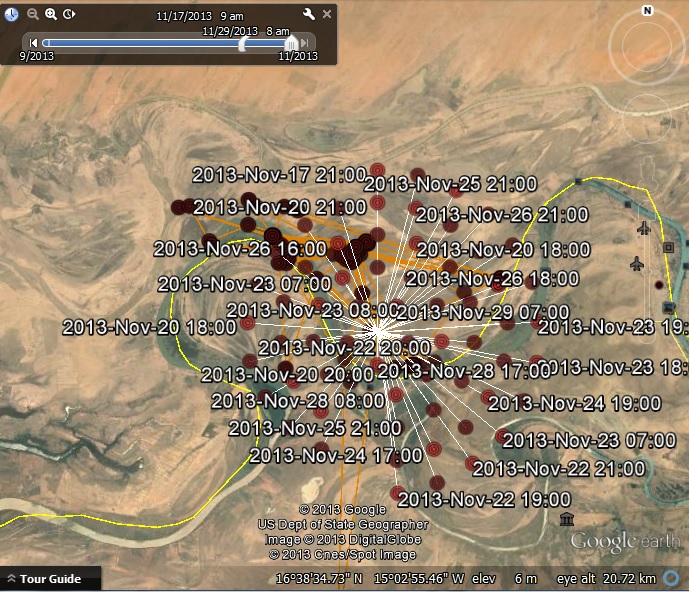Osprey Update 2nd December
Our young Osprey Blue YD ( 2012) is still doing well in Africa and has stayed in his usual haunts on the Senegal/ Mauritania border this week. Just how much these birds are creatures of habit is revealed by the picture below, which shows how often he has used a particular roost site. He roosted in this small stand of trees for four nights in a row last week so it must be either a great vantage point or somewhere he feels particularly safe from predators. All these points below are from the same small area of a few metres square.

Some more questions about Blue YZ and satellite tracking:
Q: Is it possible that the transmitters attached to Blue 44 ( 2012) and Blue YZ (2013) were from the same batch and were faulty? Are any other birds wearing transmitters from that batch which are still working?
A: The two transmitters were from the same manufacturer, but not the same ‘batch’ and none of the other scientists using this tags as reported a problem. The other 2012 SWT chick Blue YD is wearing the same transmitter and it is still working brilliantly.
Q: Is it possible-likely that an Osprey equipped with a tracking device, might be wounded or killed by a lightning strike? Have you checked the area at the time of the last known position of a tracked bird?
A: Of course any bird may suffer lightning strike but this is considered very rare. There is no evidence of an increased risk of lightning strike to any bird wearing a satellite transmitter, of any species so far studied worldwide. Much of the tag is non conductive light weight plastic, and the aerial is not very long. We have checked the weather in the area , which was settled- it is the drier part of the year in Guinea Bissau just now. Today it is settled, dry and 33 degrees centigrade.
Q: Can you tell anything by her movements in the few days before you lost signal altogether to indicate she was starving, such as not moving around much, or did it seem a sudden stop in movement, suggesting maybe that she was killed by something?
A: Good question- Blue YZ’s movements did seem to slow down a lot over her last few days which is why we are pessimistic about her fate. This is usually consistent with an ill or exhausted bird struggling to get by, rather than a sudden predation. However, as we explained, the only way to be certain would be to visit the site to find remains and or talk to locals, which is not currently possible.
Q: You describe Blue YZ as ” Tragically lost” in your previous blog. Surely the only thing we know for definite is that the transmitter has stopped working?
A: You are of course correct, we cannot be entirely sure that the bird has perished without finding a body on site, however we do believe that in all probability she is dead. This is because of her behaviour prior to transmission ceasing – the experts have told us this pattern is typical. By contrast you may remember in 2012 , Blue 44’s data was very different just before he disappeared ” off the radar” so to speak, which meant we had more hope he may have survived and it was just a technical problem.
Q: If we now have enough info on where the birds go , how high and how far they fly and to what countries they go to , do we really need to sat tag any more ? That’s two in successive years that have this tag on and have now vanished. Maybe the tags have something to do with it ?
A: Our satellite tracking project is being undertaken to contribute to the UK and European wide scientific research into this species to better aid its conservation. The number of birds so far satellite tagged is still incredibly small, and each one s still teaching us new invaluable things about migration and the risks ospreys face.
Young ospreys leaving Loch of the Lowes and Scotland have sadly perished every year , it is just that we never had this privileged insight into their fates before. We must stress that though it is upsetting to loose two birds during this project, it is entirely within the realms of normal juvenile mortality for this species that we expected. Scientists working with ospreys estimate between 50 and 70% of young birds don’t survive the first year, so our loss of two out of three is entirely normal. The results from satellite tracking studies so far show the same proportional rate of loss of birds that are tagged, to those not tagged. There is no evidence to prove that the tags increase mortality in ospreys or adversely influence their behaviour. If there was, we would not be using this technique as the birds welfare and conservation is our top priority.
Ranger Emma
Help protect Scotland’s wildlife
Our work to save Scotland’s wildlife is made possible thanks to the generosity of our members and supporters.
Join today from just £3 a month to help protect the species you love.
Preface
Our young Osprey Blue YD ( 2012) is still doing well in Africa and has stayed in his usual haunts on the Senegal/ Mauritania border this week. Just how much …
